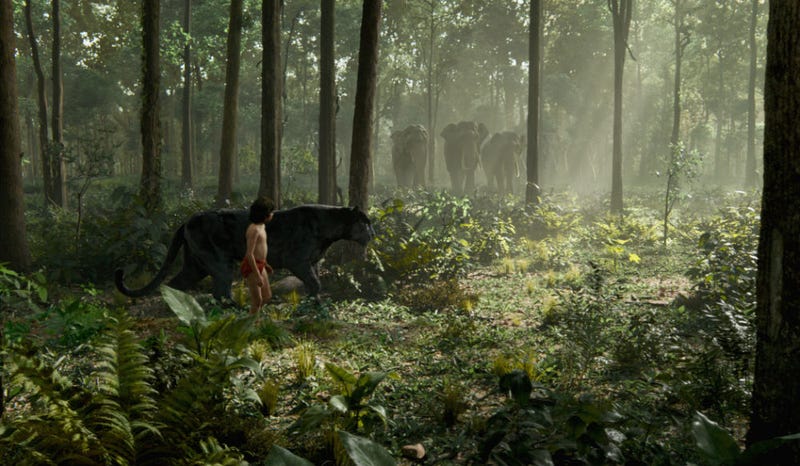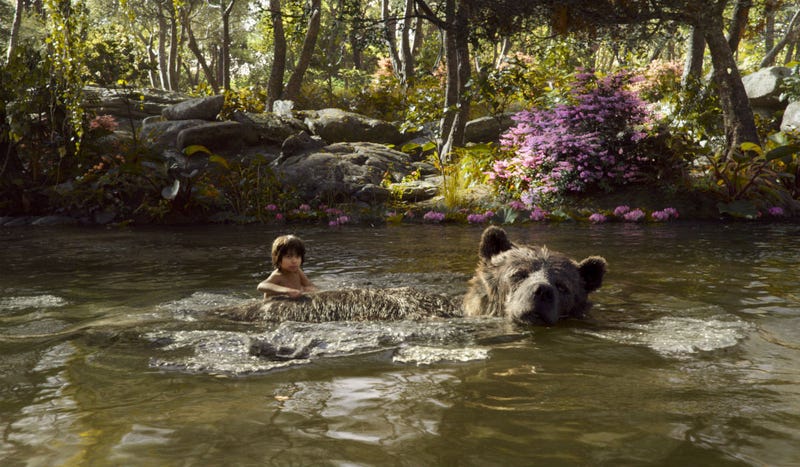
This April, when audiences sit down to see Disney’s new live-action movie of The Jungle Book, they aren’t going to think about its technical achievements. Ideally, they’re going to get swept up in a story about a boy named Mowgli and his adventures in the jungle with a bunch of talking animals. But technical achievements are almost all director Jon Favreau has been thinking about since day one.
Despite the lush environments and realistic looking animals, none of The Jungle Book was shot on location. Actually, all of it was shot in a big empty building in downtown Los Angeles. Meaning that everything you see on screen—with the exception of actor Neel Sethi, who plays Mowgli—is computer generated and animated. And yet, this isn’t Inside Out or Frozen. This is still considered a live action movie, and making the action believable was one of the biggest challenges facing Favreau as he tried to bring Rudyard Kipling’s classic tale to life one more time.
Favreau and his visual effects supervisor Rob Legato spoke to a group of press in Disney’s El Capitan Theater in January, and talked all about the challenges and goals they had on this latest incarnation of The Jungle Book.

Favreau’s resume is filled with effects movies, big and small. From Zathura and Elf, to Iron Man and Cowboys and Aliens, he’s done a little of everything. And yet, the director made some big claims about The Jungle Book. “This process is so technical, and so different from anything I’ve done,” he said. “And quite different from anything anybody’s done before.”
Obviously he’s not just talking about using a lot of visual effects. Plenty of movies use a lot of visual effects. What Favreau means is using visual effects for a film that’s not a big blockbuster. The Jungle Book isn’t Avatar or The Hobbit. It’s a small, family-friendly, character driven story, that most people already know.
“Big action spectacles are the only films that seem to make studios comfortable enough to use this level of artistry and technology in storytelling,” Favreau said. “And so the unique opportunity I’ve had is to use it for humor and emotion. Showing nature, showing animals—and really getting into that deep, mythic imagery, that always marries well with technology and always has. And so that’s fun for me.”
Luckily, Disney was in a unique position to make that happen. The company has seen huge success with live-action adaptations of its classic animated films (Cinderella, Alice in Wonderland, Maleficent, etc.) so the executives felt taking a gamble on this process, and Favreau, might pay off similarly.
“The idea of going out to the jungle and shooting this just felt like it wouldn’t have the magic the ’67 film had,” Favreau said. “There was a dreamlike quality to it. There was a surreal quality to it. It was a high-water mark for character animation, because of the character and the emotion and the music. And that’s what I remember about it, and so I wanted to make sure we preserved that.”

So Alan Horn, the head of Walt Disney Studios, told Favreau to look at Life of Pi or Gravity, films that depend on technology without flaunting it. “Why not use the technology to create a whole world that transports you?,” Horn asked Favreau. “Why be limited by going off and shooting plates? Let’s really embrace this new technology and see what we can do if we push it to its limit.”
Because of the expense of this effects-driven film-making process, the film-makers couldn’t afford to shoot anything that they weren’t going to use. So The Jungle Book was made with a similar process to Disney and Pixar’s animated films, with a real focus on nailing the story before moving forward.
“You’re constantly reinventing and exploring,” Favreau said. “We started off as though it was an animated film, with the story department, and we really stress-tested the story as you would with an animated film—because you don’t want any scenes on the cutting room floor.”
When they actually went to shoot, the stages were largely empty, comprised of nothing more than lots of green screens, cameras and actors in motion capture suits.
“We had a motion-capture volume, we had actors playing the parts, we had suits, we had sets that were lined up with what the digital set looked like. And then we captured it,” Favreau said. “First we had an animatic version, as you would on an animated film, then a motion-capture version that we edited, and then finally we took that and shot the kid as though he were an element.”

And yet, filming was the easy part. Translating the actors into animals was a little less easy, but doable for top notch effects houses. But the biggest challenge facing the crew of The Jungle Book was the main element that’s not at all realistic.
“Making the animals talk was the hardest part of the process,” Favreau said. “It was done on a shot by shot basis. There are certain animals that talk well. Other ones, it’s harder. A snake is harder, because you don’t want to make it move in the way required to make the sound. So we always erred on the side of subtly. Plus we’re really smart about the camera angle, lighting, and where the camera is. Look at Bambi again. You’ll notice a lot of the time the camera is not on who’s talking.”
And while they could cheat from time to time, most of the time they couldn’t.
“If the animals don’t look like they’re talking, the movie doesn’t work,” Favreau continued. “Forget about tracing, water simulations, and all the technology. If you don’t have them talking [it won’t work]. So I brought in footage. Let’s look at Beverly Hills Chihuahua. What did they do wrong, what did they do right? Let’s look at Dog With A Blog, let’s look at everything.”
At this event, Favreau screened four clips for the press, and the talking issue was a moot point. Actually, everything tech-wise was a moot point. The movie looks like live action, plain and simple. We’ve always wondered if you could push animation far enough to duplicate reality, and The Jungle Book may be the closest thing we’ve seen to that yet. And the question of whether these backgrounds are real stops mattering, once you start following the characters and action on screen.

The first scene we saw featured the tiger Shere Khan (voiced by Idris Elba) coming down to the watering hole and smelling Mowgli. Next we saw the panther Bagheera (Ben Kingsley) trying to get Mowgli away, only to battle Shere Khan to facilitate the boy’s escape. Next was a scene of Mowgli being presented to the giant ape King Louie (Christopher Walken) and finally, one of the first scenes of Mowgli meeting Baloo (Bill Murray). Each scene looked picture perfect, and had the good-humored sense of adventure that you’d expect from the film.
Whether or not all of those scenes will come together to capture the “dreamlike quality” Favreau is going for, we won’t know until we see them in context on April 15. But there’s little doubt that—like Life of Pi, Avatar, Gravity and other films before it—The Jungle Book has done its due diligence to push digital effects to another level.